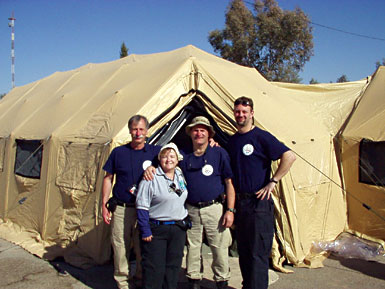Vital Signs
DHMC volunteers help out after Iran earthquake
"We've seen a lot of property damage and a lot of disruption, but for the human toll—in terms of deaths and injuries—something like that I've never seen before." That's the reaction of Robert Gougelet, M.D., one of three DHMC emergency medicine experts who rushed to Bam, Iran, after a devastating earthquake there killed more than 41,000 people; injured 30,000; and left 75,000 homeless.
Team: Gougelet and DHART crew chief John Hinds and paramedic Chip Cooper are members of the Boston-based International Medical Surgical Response Team (IMSuRT)-East. The team was deployed to Iran shortly after the December 26 disaster.

|
|
Gougelet (left), Cooper (right), and Hinds (second from right) are pictured in Iran with a fellow IMSuRT volunteer. |
Though they're seasoned disaster volunteers—having helped in the aftermath of hurricanes, typhoons, floods, earthquakes, and even September 11—the DHMC trio was stunned by the extent of the damage in Bam. "It was almost homogenous—street after street of just piles of bricks and collapsed buildings," recalls Cooper. "Everything was collapsed. The doctors were gone. Their pharmacies were gone. They didn't have any resources other than what the Red Crescent Society, which is their version of the Red Cross, provided to them."
Once in Iran, the team wasted no time in setting up a field hospital—with seven tents, 63 personnel, and thousands of pounds of medical equipment and pharmaceutical supplies that they'd brought with them. Fortunately, they know how to work under difficult conditions and with limited resources.
"You have to be flexible," says Hinds. "You have to work with the things that you have and work around the things that you don't have, plain and simple. Here in the United States we have a lot of disposables. Over there you don't have the disposables. You have to reutilize things. A bucket of water may be used for one patient here in the U.S. It may be used for 30 patients over there—for casting or whatever. You have to think outside the box . . . look beyond what's right in front of you."
So when the volunteers needed cribs for six babies born in the field hospital, they fashioned bassinets out of pistachio boxes. "We lined them with cotton and other padding and used a couple of high-powered spotlights as warmers," says Cooper.
IMSuRT was one of several disaster relief teams in Bam. "We took care of some of the urgent conditions," says Gougelet. "We did six deliveries. . . . I took care of a gunshot wound. I took care of a little girl with a subdural hematoma. These are things that essentially would occur in the course of a normal day, but they would have had hospitals to take care of [them]."
In addition, he says, "posttraumatic stress was significant. . . . One fellow lost 22 family members, another fellow lost 14 family members."
By the time IMSuRT had finished its 72-hour assignment, the Red Crescent was ready to take over. IMSuRT did leave behind all the equipment and supplies they'd brought along, donating them to the effort.
IMSuRT is a cooperative effort of the National Disaster Medical System and the Department of State. Additional teams are now being established in other regions of the U.S.
Gratitude: Gougelet, Hinds, and Cooper were touched by the Iranians' expressions of gratitude. "People are people," says Hinds. "When you have a horrific accident . . . they are no different than anybody else in the world. The Iranian folks, even the military and the police, showed that day in and day out. They were very appreciative."
The IMSuRT team saw over 700 patients during its 72-hour stint. The family of one showed its appreciation in a particularly touching way. "They actually named one of the babies after us," says Cooper. "IMSuRT."
Laura Stephenson Carter
